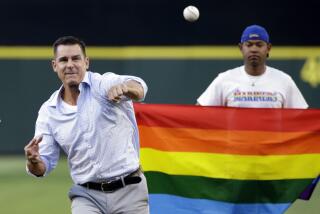Tips on the Game of Life : Former Negro League Players Visit School to Educate and Inspire
- Share via
WESTMINSTER — In his youth, Sammie Haynes was one of the best baseball players around, sharing the diamond with such legends as Jackie Robinson, Satchel Paige and Willie Mays. Still, Haynes never got a chance to prove himself in the major leagues during his heyday in the 1930s and early 1940s because of the color of his skin. Instead of playing for the New York Yankees or the Chicago Cubs, Haynes played for the Kansas City Monarchs, the premier team in the Negro American League.
As part of the Westminster School District’s Black History Month celebration, Haynes, 73, spoke Tuesday to students at Frank N. Eastwood Elementary School about the triumphs of black ballplayers in and out of the Negro leagues, about segregation and about the importance of staying in school.
Before an audience of about 250 students, Haynes described how desperately he wished to play for the Monarchs. He recalled that after four years as catcher on an Atlanta team, he got his break. He said, “If God asked, ‘Sammie, do you want to go to Kansas City or heaven?’ I would have said, ‘Lord, I want to go to Kansas City.’ ”
Haynes, along with former Negro league ballplayers Merle Porter and Fran Matthews, reminisced about crisscrossing the country by bus, playing as many as three games in a day for love of the sport and not much money.
The men, who live in Los Angeles now, recalled games they played with the likes of Robinson, Paige and Mays before blacks were allowed into the major leagues. That breakthrough came in 1945, when Robinson signed with the Brooklyn Dodgers. Haynes said black players did not often dwell on being excluded from the major leagues “because we knew we were playing some of the best players alive.”
Still, Negro league players did occasionally play their major league counterparts during the off-season. Haynes noted that during one series of games, his team beat the St. Louis Cardinals 14-0. “That didn’t play too well” with the crowd, he quipped.
“Black baseball is one of the best-kept secrets of black history,” said Matthews, 76, who played first base for the Newark Eagles. “I played with 10 people who should be in the Hall of Fame. I played. I loved it. I’m proud of it.”
Porter, 72, who also played first base for several teams, including the New Orleans Creoles and Kansas City Monarchs, spoke less about his own past than the students’ future. “You can’t make it like we did. All we needed was a high school diploma. Now, you need a resume and you need it up here,” he said, tapping his forehead. “Stay in school, that’s the only way you can make it.”
Porter also urged students interested in baseball to practice and try hard, adding that he believes women will play in the major leagues in the next decade or two.
Haynes, who lost his vision to glaucoma 30 years ago, emphasized that point, telling students not to be deterred by any obstacles or disabilities they may face. “You can work hard and overcome it,” he said.
After the assembly, the men signed autographs for several dozen students, who said they were thrilled to meet the players.
“It was neat. I learned about how it was back then and how they could play,” said Sandra Vinciguerra, 11, holding a baseball that the trio had signed.
Paul Bennett, also 11, said the visit “has kids notice that black leaders did a lot for our country, the same as whites did, and we ought to recognize them a lot more than we do. I think this is really cool. I can walk into a baseball card store and say I met these guys.”
More to Read
Go beyond the scoreboard
Get the latest on L.A.'s teams in the daily Sports Report newsletter.
You may occasionally receive promotional content from the Los Angeles Times.










